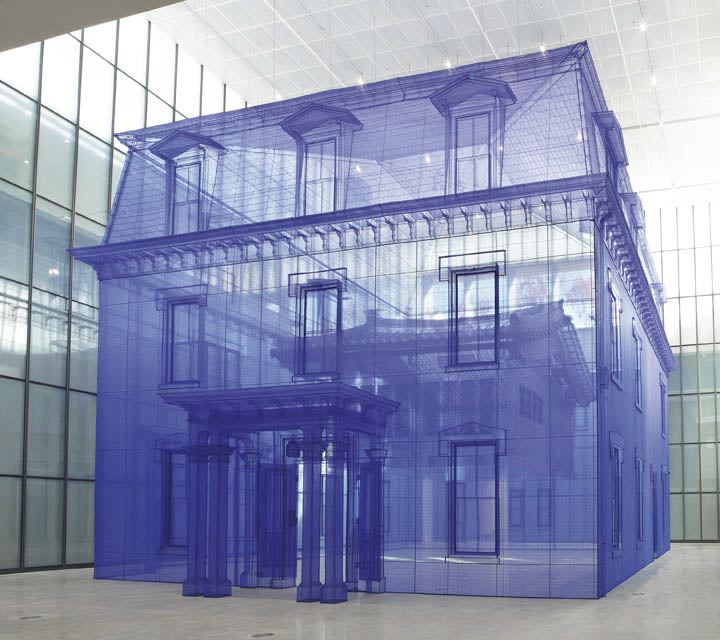do ho suh: the house as an area of deconstructive provocation
BY GÜLAY YAŞAYANLAR
Do Ho Suh disrupts the everyday rhythm of objects and reduces them to remnant traces of identity. Likewise, the deconstructed red stairway also becomes a gateway to another conceptual tragedy. Thus, Suh’s meticulous, playful, drama-based design approach can be reconfigured with each different experience. And these configurable, transposable possibilities of space become reflections of an emotionally-charged past as records of memory that surround the void.

Do Ho Suh, Home within Home within Home within Home within Home, 2013, polyester fabric, metal frame, 602.36 x 505.12 x 510.63 inches. © Do Ho Suh. Courtesy the artist and Lehmann Maupin, New York, Hong Kong, Seoul, and London. [ https://www.lehmannmaupin.com/artists/do-ho-suh ]
Bolstered by architectural elements and formed in excess, Do Ho Suh’s sculptural works are bolstered by a fluid and dynamic conceptual framework.[i] The installations, set up dramatically around a concept of home with stainless steel pipes and translucent polyester fabric; attain an uncanny, intermeshed sense of holism between the exposed, open interior, and void-based maps of remembrance.
The installations, formed around a pivotal concept such as the home with all its entailing structures and everyday objects; confront the psychic realism of the self and its transformation by tracing lived-in memories. The home, almost made defunct, becomes a nether-place dedicated to an uncanny temporality; perishable, diaphanous stage/locales, and personal, psycho-analytical indicators.
adding mystery to a story of alienation
Do Ho Suh’s compound installations emphasize the definitive differences between Western and Asian forms of architecture; and express the utter limits personal isolation and the sense of alienation. His large 2013 installation, Home Within Home, expresses this sentiment with a conflicting sense of spirituality.[ii]
Suh’s domestic architecture clearly expresses an emotional sentiment that tries to dispel anxieties of alienation in an environment of multiple possibilities for entrance and exits, presented by architectural elements such as doors, corridors and staircases. The artist means to bypass the spiritual weight brought about by his culturally-transient lifestyle through an idea of the mystifying, empty, intermeshed, translucent home/room. For this reason, he designs his installations as symbolic locations dedicated to re-experiencing traumatic memories; and conceptualizes them within their own neurotic order.
At this juncture, Suh points us towards the alienating, distorting force of his ability to re-present the ideal forms of domestic constituents; and his constant interrogations of his own conflicts of identity.
Suh thus develops a metaphoric domestic order dedicated to the sense of alienation with all its ironic and characteristic visuals and references. For example, the artist’s work, titled Staircase III, displays a sense of impossible locational passage with its iconic, floating red stairs.[iii] Like this staircase, Suh’s other architectural elements and everyday objects lose their details and regular function; and evolve into phantom forms thanks to Suh’s deconstructive reductionism.
do ho suh / an unsettling interior or a deconstructive provocation
Do Ho Suh’s performative approach can be likened to an interrogation dedicated to exposing the passage of time, the intensity of contemporary thought and emotion, and the memories trapped in-between through phantasmagoric constructs. For this reason, it is common to see consecutive or intermeshed elements in a single work like short excerpts from a movie of life – as is apparent in his installations entitled Passage/s.[iv] This is a potent commentary on the changing meaning of the concept of home against time. By reproducing every domestic element such as bathtubs, ovens and toilet seats with fabric veils, wire and string, Suh disrupts the everyday rhythm of objects and reduces them to remnant traces of identity. Likewise, the deconstructed red stairway also becomes a gateway to another conceptual tragedy. Thus, Suh’s meticulous, playful, drama-based design approach can be reconfigured with each different experience. And these configurable, transposable possibilities of space become reflections of an emotionally-charged past as records of memory that surround the void.
It is inevitable for such constructed likenesses of domestic life to gain an aspect of intense emotionality in our present day world order of walls, borders and frustrations. This stems in part from the contemporary sense of desires and chaos that result from an age of alienation and cultural change. In this respect, Suh’s unsettling interiors stand before us as representations of a rule less, conjoined inner world interwoven with tales of displacement. The resulting fluid architecture, shaped by intellectual concerns and linked to the creation of imaginary buildings, stands out as a perfect strategy of representational belonging, or an area of deconstructive provocation. (Translated by: C.M. Kösemen)
Gülay Yaşayanlar, Copyright © 2022 / All Rights Reserved.
See: https://saglamart.com/do-ho-suh-rubbing-loving-project-2016-touching-memories-and-hidden-time
[i] Do Ho Suh (b. 1962, Seoul, Korea; lives and works in London, United Kingdom) works across various media, creating drawings, film, and sculptural works that confront questions of home, physical space, displacement, memory, individuality, and collectivity. Suh is best known for his fabric sculptures that reconstruct to scale his former homes in Korea, Rhode Island, Berlin, London, and New York. Suh is interested in the malleability of space in both its physical and metaphorical forms, and examines how the body relates to, inhabits, and interacts with that space. He is particularly interested in domestic space and the way the concept of home can be articulated through architecture that has a specific location, form, and history. For Suh, the spaces we inhabit also contain psychological energy, and in his work he makes visible those markers of memories, personal experiences, and a sense of security, regardless of geographic location. [https://www.lehmannmaupin.com/artists/do-ho-suh/biography]
[ii] Home within Home an installation in which the viewer simultaneously stays in and out or wanders under, includes a radical installation proposal. See. Do Ho Suh, “Home within Home”, 2013, Installation with Metal Construction and Polyester Fabric, 602.3×505.1×510.6 cm. [www.saic.edu.2018]
[iii] Do Ho Suh uses a translucent red polyester fabric for the stair installations, which contrasts with the solidity of the architectural structure. In these arrangements, he uses the insistent choice of red fabric as a way of removing the building from its original context and perceiving the recognizable floating structure as if it were in a dream setting. See. [ https://delood.com/archive/art-archive/do-ho-suh-staircase-iii/ ]
[iv] Do Ho Suh creates life-size corridors, passages, door entrances and gaps referring to the places where he lived in the past in the spatial structures he created from transparent plastic tulle. See. Do Ho Suh, Hallway, ARoS Aarhus Kunstmuseum 2019.



